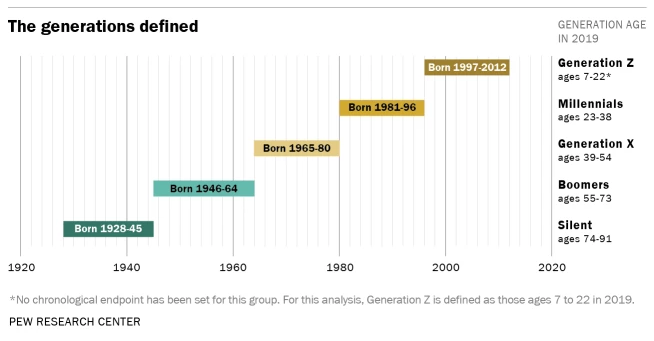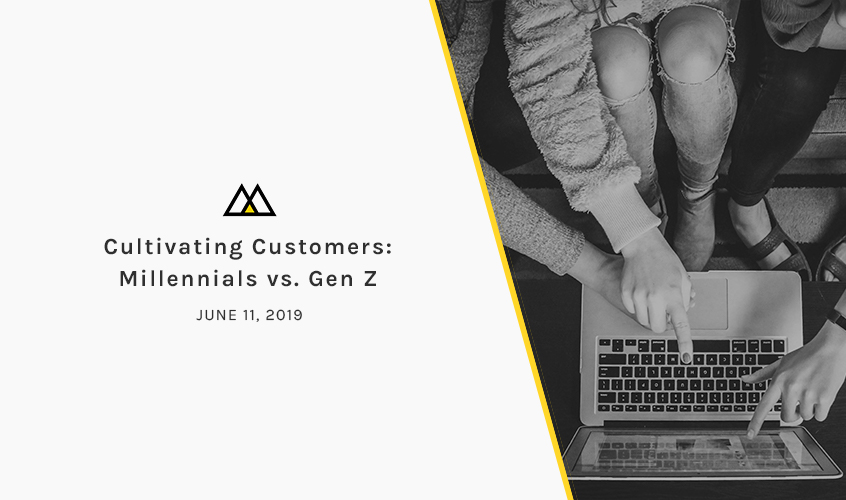Cultivating Customers: Millennials vs. Gen Z
Understanding the differences between Millennials and Gen Z can help ensure that you know the best way to sell and advertise to the two generations with the fastest growing purchasing power.

Source: Pew Research Center
According to the latest U.S. Census Bureau data, Millennials have officially become the majority generation in the workforce at 35%. However, Boomers and Gen X, Millennials’ parents and Gen Z’s parents, make up 58% of the workforce. It’s important that each generation can objectively look at previous and future generations in order to understand how to target consumers and effectively sell to them.
Millennials – 1981-1996
Purchasing power: $600 billion per year in the US
More and more millennials are becoming parents, which means that finding creative ways to advertise children’s toys and baby products is important. Brands who look to differentiate themselves from legacy brands, and legacy brands who look to reinvent themselves, will prove successful. While Millennials do a considerable amount of online shopping, they also appreciate an immersive, customized retail experience.
Brand loyalty: Millennials are loyal shoppers as a result of rewards programs and good customer service. Do not rely on your brand recognition alone, that won’t ensure sales. But if they purchase from you once, they are highly likely to purchase from you again.
- 60% prefer to purchase generic brands over name brands
- 60% remain loyal to the brands they purchase
- More likely to stay loyal to a brand because of loyalty rewards than previous generations
Advertising: Millennials are not opposed to ads. Make sure they are thoughtful and specific and they will most likely respond well.
- Millennials are receptive to online advertising that is restrained, targeted and relevant
- 80% find in-feed ads that are not intrusive a good user experience
Who they’re buying from: Millennials want to know that their money is going to a good place. Millennials respond well to brands with a mission, like Toms and Bombas, who give back when purchases are made. The community surrounding the brand is also important.
- 40% refer to online reviews and testimonials before purchasing a product
- 81% expect companies to make a public commitment to charitable causes and citizenship
Source: Lexington Law Blog
Gen Z – 1997-2012
Purchasing Power: $44 billion per year in the US
One of the defining differences between Millennials and Gen Z is the use of technology. While most Millennials remember the introduction of the internet and were taught how to use a computer in school, for Gen Z it has always been second nature.
Gen Z grew up in a world that was always logged in online, with the first iPhone launched in 2007, the oldest group in Gen Z was only 10, meaning that in their formative teen years, a mobile device became one of the primary sources for information. As such, Gen Z is even more in tune with mobile shopping than their Millennial counterparts.
Advertise with a purpose: Gen Z cares about authenticity and they will sniff out an insincere, pushy sales attempt with a quick scroll of their thumb. Gen Z wants to see their own values reflected in the ads that they are being served, and shelling out large amounts for a celebrity endorsement may not be worth it.
- 19% say that they admire something or someone because they have a mass following
Social media turned selling: Social media networks are providing advertisers with ways to target the overwhelming number of Gen Z users. In May 2019 Instagram launched their @shop account and Snapchat has just launched a “shop” button for influencers. Advertisers should shift their focus from traditional advertising formats and find ways to make their brand relevant in a social media driven world.
- 90% is consuming content on social media
- 50% of Gen Z social media users have purchased items they were first exposed to in a paid social ad
They’re savvy: Millennials felt the recession, many of them graduating college and trying to enter the workforce in an economy that wasn’t hiring. Gen Z was old enough to be aware, although not as impacted. As a result, they’re planning for their future. While they’re still purchasing, they’re less likely to make impulse buys. Therefore, long-term, targeted campaigns and influencer marketing are more effective strategies to reach Gen Z consumers.
- 21% opened savings accounts before the age of 10
Source: Inc.
What this means for your strategy
Reaching Millennial and Gen Z consumers means readjusting traditional strategies. Both generations are on social media but care about authenticity and genuine connections. As more Millennials and a growing number of Gen Z workers enter the workforce, it’s important to listen to their ideas and opinions.


